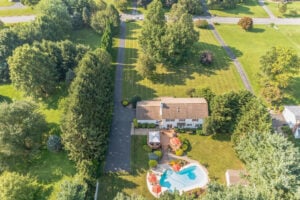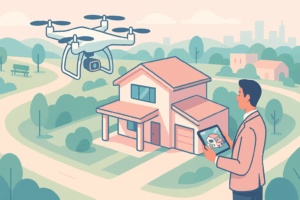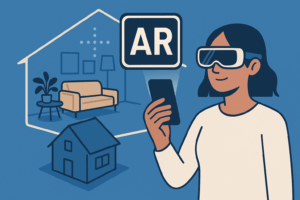HDR photography has gained considerable traction among real estate photographers, and for good reason. It offers the flexibility to capture a wider range of exposure levels in images, ensuring every detail is impeccably showcased.
For houses that are soon to be on the market, this photography technique can be a game-changer, allowing photographers to provide a true sense of the property’s features and a natural take on its environment.
Our team of professional photographers at HomeJab is here to break down the fundamentals and provide you with the information you need to understand the value of HDR photography for real estate.
What is HDR Photography?
HDR photography involves capturing multiple images of the same scene at different exposure levels, from underexposed to overexposed. These images are then merged using specialized software to create a single composite image that retains detail in both the highlights and shadows of a shot.
In other words, it is a way of giving your shot list the VIP treatment, making sure your images look their absolute best regardless of the lighting challenges you encounter that day or if conditions unexpectedly change.
Let’s say, for example, you are photographing a spacious living room with large windows that let in plenty of natural light. Without HDR, you might struggle to photograph the details of the room’s interior without blowing out the highlights outside the windows or losing the details in the darker areas of the room.
But with HDR, you can take multiple shots at different exposure levels – one exposing for the bright outdoor light, another for the dimmer indoor space, and perhaps one in between.
After blending these images using HDR software, you’ll end up with a final composite image that beautifully balances the light, preserving the important details of the room’s interior while still capturing the view outside.
The result? A well-balanced real estate image that will invite potential buyers to imagine themselves relaxing in that space.
The Benefits of HDR Photography for Real Estate
Did you know that listings with HDR imagery tend to sell a whopping 50% faster and attract 118% more views online? That’s not just a coincidence – it’s the power of HDR at work!
Yet, for photographers it’s not just about the numbers or getting the seal of approval from a real estate agent or homeowner. HDR photography also makes life easier for you, providing the insurance of capturing a moment in time from a series of light conditions.
Whether it’s the cozy corners of a breakfast nook or the breathtaking views from a primary bedroom balcony, HDR images ensures that nothing gets lost in the shadows or blown out in the highlights.
Here are other key benefits of HDR in realty photography:
- Natural-looking results: HDR images closely mimic the way the human eye perceives light, resulting in more realistic and immersive photographs that accurately represent the property.
- Increased visual appeal: These images often have a vibrant and eye-catching appearance, making them ideal for grabbing the attention of potential buyers and accurately displaying the beauty of a property.
Techniques for capturing HDR images:
Now that you have a grasp of HDR photography for real estate, let’s delve into the most effective methods for capturing HDR images. These include:
Using a tripod
First, stability is crucial when capturing multiple exposures for HDR photography. Always use a tripod to ensure that each shot aligns perfectly, minimizing blur and maximizing image sharpness.
Bracketing
Set your camera to auto-bracketing mode or manually adjust the exposure settings to capture a series of images at different exposure levels. Aim to capture a range of exposures, from underexposed to overexposed, to ensure you have enough data to work with during post-processing.
Focus Stacking
In addition to bracketing for exposure, consider focus stacking to ensure that all elements of the scene are in sharp focus. Capture multiple images at different focus points and blend them together in post-processing for maximum clarity.
Utilize Remote Trigger
Similarly, to further minimize camera shake, use a remote trigger or your camera’s built-in timer to trigger the shutter without physically touching the camera.
Best Practices for HDR Processing:
- Choose the Right Software: There are many software options available for merging and processing HDR images, including Adobe Lightroom, Photomatix, and Aurora HDR. Experiment with different programs to find the one that best suits your workflow and aesthetic preferences.
- Maintain a Natural Look: While HDR processing can produce stunning results, it’s important to avoid over-processing your images. For example, strive for a natural-looking final image that accurately represents the property without appearing overly edited or artificial.
- Fine-Tune Tone Mapping: Tone mapping is a critical step in HDR processing, as it determines the final look and feel of your image. Experiment with different tone mapping presets and sliders to achieve the desired balance of highlights, shadows, and mid-tones.
- Pay Attention to Details: Take the time to carefully blend and retouch your HDR images, paying close attention to details such as color balance, contrast, and noise reduction. Lastly, you want to aim for a polished final result that showcases the property in the best possible light.
Overview
Overall, with the insights and tips shared in this blog post, you’re poised to elevate your real estate photography skills and produce high-quality visuals that both resonate with prospective buyers and leave a favorable impression upon sellers. Additionally, you’ll gain a competitive edge in the real estate market, distinguishing yourself as a photographer who delivers exceptional results.
If you have more insights to share or questions about HDR photography for real estate, feel free to drop a comment below. Alternatively, if you’re a professional photographer with experience in HDR images, head over to the HomeJab website for more information on joining the team.















